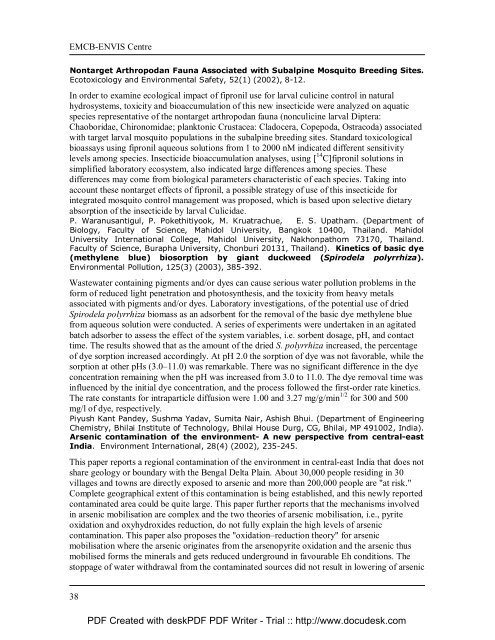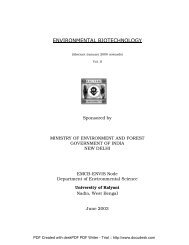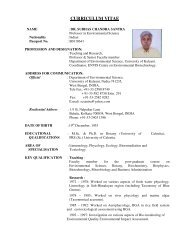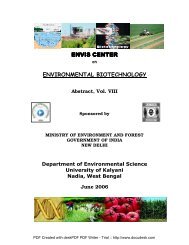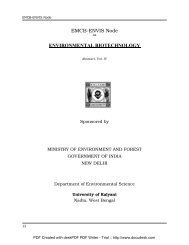EMCB-ENVIS Node ENVIRONMENTAL BIOTECHNOLOGY
EMCB-ENVIS Node ENVIRONMENTAL BIOTECHNOLOGY
EMCB-ENVIS Node ENVIRONMENTAL BIOTECHNOLOGY
Create successful ePaper yourself
Turn your PDF publications into a flip-book with our unique Google optimized e-Paper software.
<strong>EMCB</strong>-<strong>ENVIS</strong> Centre<br />
Nontarget Arthropodan Fauna Associated with Subalpine Mosquito Breeding Sites.<br />
Ecotoxicology and Environmental Safety, 52(1) (2002), 8-12.<br />
In order to examine ecological impact of fipronil use for larval culicine control in natural<br />
hydrosystems, toxicity and bioaccumulation of this new insecticide were analyzed on aquatic<br />
species representative of the nontarget arthropodan fauna (nonculicine larval Diptera:<br />
Chaoboridae, Chironomidae; planktonic Crustacea: Cladocera, Copepoda, Ostracoda) associated<br />
with target larval mosquito populations in the subalpine breeding sites. Standard toxicological<br />
bioassays using fipronil aqueous solutions from 1 to 2000 nM indicated different sensitivity<br />
levels among species. Insecticide bioaccumulation analyses, using [ 14 C]fipronil solutions in<br />
simplified laboratory ecosystem, also indicated large differences among species. These<br />
differences may come from biological parameters characteristic of each species. Taking into<br />
account these nontarget effects of fipronil, a possible strategy of use of this insecticide for<br />
integrated mosquito control management was proposed, which is based upon selective dietary<br />
absorption of the insecticide by larval Culicidae.<br />
P. Waranusantigul, P. Pokethitiyook, M. Kruatrachue, E. S. Upatham. (Department of<br />
Biology, Faculty of Science, Mahidol University, Bangkok 10400, Thailand. Mahidol<br />
University International College, Mahidol University, Nakhonpathom 73170, Thailand.<br />
Faculty of Science, Burapha University, Chonburi 20131, Thailand). Kinetics of basic dye<br />
(methylene blue) biosorption by giant duckweed (Spirodela polyrrhiza).<br />
Environmental Pollution, 125(3) (2003), 385-392.<br />
Wastewater containing pigments and/or dyes can cause serious water pollution problems in the<br />
form of reduced light penetration and photosynthesis, and the toxicity from heavy metals<br />
associated with pigments and/or dyes. Laboratory investigations, of the potential use of dried<br />
Spirodela polyrrhiza biomass as an adsorbent for the removal of the basic dye methylene blue<br />
from aqueous solution were conducted. A series of experiments were undertaken in an agitated<br />
batch adsorber to assess the effect of the system variables, i.e. sorbent dosage, pH, and contact<br />
time. The results showed that as the amount of the dried S. polyrrhiza increased, the percentage<br />
of dye sorption increased accordingly. At pH 2.0 the sorption of dye was not favorable, while the<br />
sorption at other pHs (3.0–11.0) was remarkable. There was no significant difference in the dye<br />
concentration remaining when the pH was increased from 3.0 to 11.0. The dye removal time was<br />
influenced by the initial dye concentration, and the process followed the first-order rate kinetics.<br />
The rate constants for intraparticle diffusion were 1.00 and 3.27 mg/g/min 1/2 for 300 and 500<br />
mg/l of dye, respectively.<br />
Piyush Kant Pandey, Sushma Yadav, Sumita Nair, Ashish Bhui. (Department of Engineering<br />
Chemistry, Bhilai Institute of Technology, Bhilai House Durg, CG, Bhilai, MP 491002, India).<br />
Arsenic contamination of the environment- A new perspective from central-east<br />
India. Environment International, 28(4) (2002), 235-245.<br />
This paper reports a regional contamination of the environment in central-east India that does not<br />
share geology or boundary with the Bengal Delta Plain. About 30,000 people residing in 30<br />
villages and towns are directly exposed to arsenic and more than 200,000 people are "at risk."<br />
Complete geographical extent of this contamination is being established, and this newly reported<br />
contaminated area could be quite large. This paper further reports that the mechanisms involved<br />
in arsenic mobilisation are complex and the two theories of arsenic mobilisation, i.e., pyrite<br />
oxidation and oxyhydroxides reduction, do not fully explain the high levels of arsenic<br />
contamination. This paper also proposes the "oxidation–reduction theory" for arsenic<br />
mobilisation where the arsenic originates from the arsenopyrite oxidation and the arsenic thus<br />
mobilised forms the minerals and gets reduced underground in favourable Eh conditions. The<br />
stoppage of water withdrawal from the contaminated sources did not result in lowering of arsenic<br />
38<br />
PDF Created with deskPDF PDF Writer - Trial :: http://www.docudesk.com


